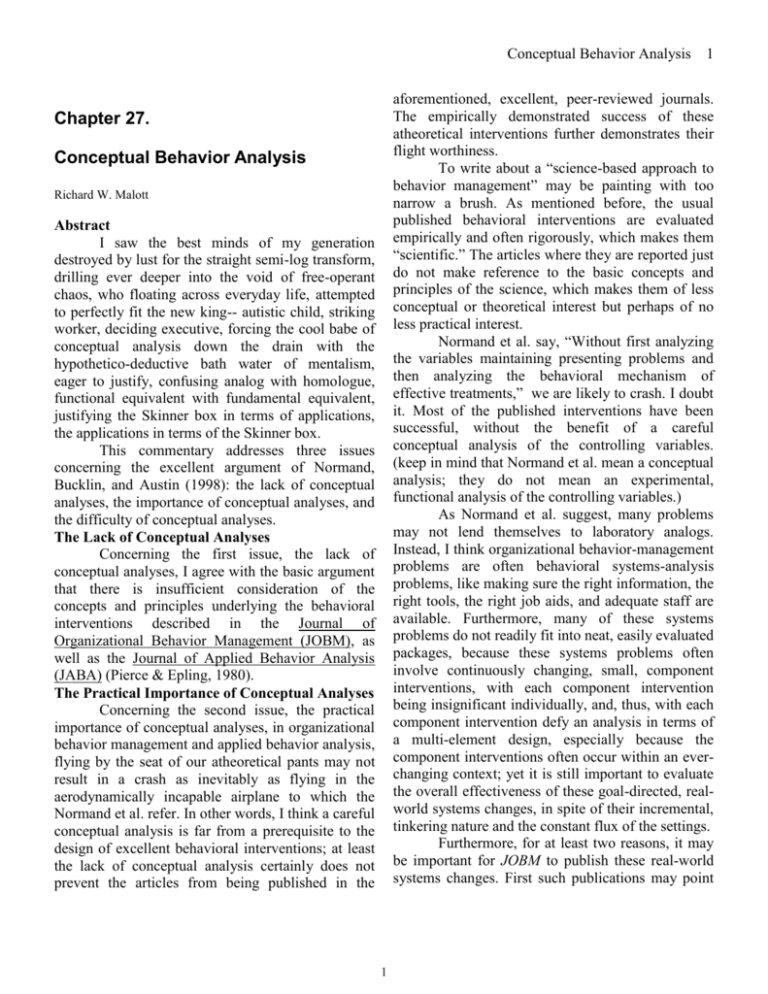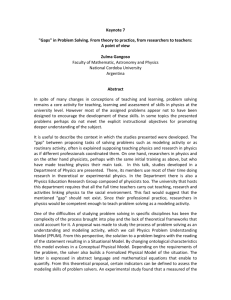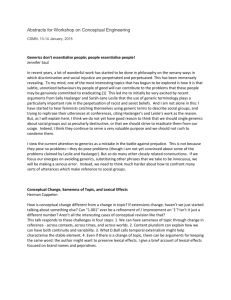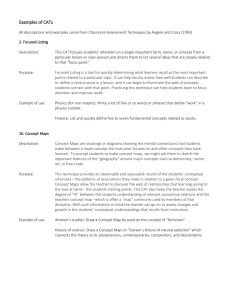Conceptual Behavior Analysis
advertisement

Conceptual Behavior Analysis 1 aforementioned, excellent, peer-reviewed journals. The empirically demonstrated success of these atheoretical interventions further demonstrates their flight worthiness. To write about a “science-based approach to behavior management” may be painting with too narrow a brush. As mentioned before, the usual published behavioral interventions are evaluated empirically and often rigorously, which makes them “scientific.” The articles where they are reported just do not make reference to the basic concepts and principles of the science, which makes them of less conceptual or theoretical interest but perhaps of no less practical interest. Normand et al. say, “Without first analyzing the variables maintaining presenting problems and then analyzing the behavioral mechanism of effective treatments,” we are likely to crash. I doubt it. Most of the published interventions have been successful, without the benefit of a careful conceptual analysis of the controlling variables. (keep in mind that Normand et al. mean a conceptual analysis; they do not mean an experimental, functional analysis of the controlling variables.) As Normand et al. suggest, many problems may not lend themselves to laboratory analogs. Instead, I think organizational behavior-management problems are often behavioral systems-analysis problems, like making sure the right information, the right tools, the right job aids, and adequate staff are available. Furthermore, many of these systems problems do not readily fit into neat, easily evaluated packages, because these systems problems often involve continuously changing, small, component interventions, with each component intervention being insignificant individually, and, thus, with each component intervention defy an analysis in terms of a multi-element design, especially because the component interventions often occur within an everchanging context; yet it is still important to evaluate the overall effectiveness of these goal-directed, realworld systems changes, in spite of their incremental, tinkering nature and the constant flux of the settings. Furthermore, for at least two reasons, it may be important for JOBM to publish these real-world systems changes. First such publications may point Chapter 27. Conceptual Behavior Analysis Richard W. Malott Abstract I saw the best minds of my generation destroyed by lust for the straight semi-log transform, drilling ever deeper into the void of free-operant chaos, who floating across everyday life, attempted to perfectly fit the new king-- autistic child, striking worker, deciding executive, forcing the cool babe of conceptual analysis down the drain with the hypothetico-deductive bath water of mentalism, eager to justify, confusing analog with homologue, functional equivalent with fundamental equivalent, justifying the Skinner box in terms of applications, the applications in terms of the Skinner box. This commentary addresses three issues concerning the excellent argument of Normand, Bucklin, and Austin (1998): the lack of conceptual analyses, the importance of conceptual analyses, and the difficulty of conceptual analyses. The Lack of Conceptual Analyses Concerning the first issue, the lack of conceptual analyses, I agree with the basic argument that there is insufficient consideration of the concepts and principles underlying the behavioral interventions described in the Journal of Organizational Behavior Management (JOBM), as well as the Journal of Applied Behavior Analysis (JABA) (Pierce & Epling, 1980). The Practical Importance of Conceptual Analyses Concerning the second issue, the practical importance of conceptual analyses, in organizational behavior management and applied behavior analysis, flying by the seat of our atheoretical pants may not result in a crash as inevitably as flying in the aerodynamically incapable airplane to which the Normand et al. refer. In other words, I think a careful conceptual analysis is far from a prerequisite to the design of excellent behavioral interventions; at least the lack of conceptual analysis certainly does not prevent the articles from being published in the 1 Conceptual Behavior Analysis to the emerging universality of some systematically replicated intervention packages. And, second, such publications may provide the university researcher/teachers with models of what real-world organizations are willing to pay for, thus, perhaps increasing the emphasis on training graduate students to do the sort of behavioral interventions and evaluations they will be doing once they graduate, rather than the JABA-style intervention and evaluation methodology that dominates so much of our current applied behavior analysis and OBM undergraduate and graduate training. The authors say, “This lack of a functional assessment makes it difficult for readers to decide if a proposed intervention is applicable to a situation with which they might be dealing.” I doubt if most real-world consumers understand correct, conceptual behavior analyses, let alone make use of such analyses in selecting an intervention; whether something is a rule-governed analog to avoidance of the loss of a reinforcer or simple, plain-vanilla reinforcement is far from the deciding factor for such consumers. In fact, calling something the conceptually nonsensical differential reinforcement of other behavior may put the politically correct gloss and consumer-oriented spin on a procedure whose dark, aversive-control underbelly would be revealed by a thoughtful conceptual analysis to be punishment by the prevention of the presentation of a reinforcer. And calling a procedure overcorrection rather than the more technically correct punishment by the presentation of an aversive condition may allow us to slip an effective procedure over on an aversive-control phobic institutional review board. In addition, such conceptual obfuscation of aversiveness may allow those applied behavior analysts concerned with the fallout of coercion to comfortably look in the mirror every morning as they shave or put on their lipstick or both. In short, I think correct conceptual analyses will exert little positive control over the behavior of the consumer. The Difficulty of Conceptual Analyses. And concerning the third issue, correct conceptual analyses are very difficult. Therefore, requiring such analyses may not suffice, because the skills of precise conceptual analysis are not learned 2 by most applied behavior analysts, regardless of their record of publication in JOBM and JABA. We train and over train our students in experimental methodology to the point that a good review paper is not one that points to underlying conceptual continuity or new conceptual generality. Instead a good review paper is considered to be one that points out that most of the research was group design and therefore inferior to multi-element, multiple-baseline, varying criterion, reversal, singleorganism design, systematically replicated across organisms, behaviors, and settings, with an interobserver reliability of .97%. Our over emphasis on training to classify research designs seems to compete with training to do conceptual analyses. Furthermore, when behavior analysts do allude to a conceptual analysis, they often make a reference to the principles derived from “scientific research.” They seem to do this for the prestige it implies, so they can say, we are scientific and all them other guys ain’t. So they can imply they have on their white lab coats when they say, always use reinforcement, always accentuate the positive, always catch ‘em being good. And even when behavior analysts are not trying to cloak their recommendations with the mantle of “science,” their explicit or implicit conceptual analyses are too simplistic, for example: Simplisticism #1: Use descriptive praise, even with non-verbal clients. Simplisticism #2: Rule-governed analogs with outcomes that are delayed by hours, days, or weeks, are really instances of simple, Skinner-box reinforcement which can be explained in terms of the molar matching law. Simplisticism # 3: A day’s work is a reinforceable response unit, just like the rat’s lever press. Simplisticism #4: The weekly paycheck is an FI (fixed-interval)-scheduled reinforcer. Simplisticism #5: Congress’ law passing is reinforced on an FI schedule. Simplisticism #6: Rule-governed behavior mediates delays between behavior and consequences in organizational settings. Science vs. Engineering I think a big part of our problem is that we often try to be too “scientific.” Often we think we are doing basic research, when we are really doing behavioral 2 Conceptual Behavior Analysis engineering. Thus our over emphasis on research methods. Furthermore, our uncritical quest for scientific respectability (rather than conceptual purity) may explain why our frame of reference is often the superficial trappings of the Skinner box, rather than the fundamental principles that must underlie even the most fashionable of current basicresearch topics. Because of a superficial understanding of the principles of behavior, we seek to reinforce work behavior on a fashionable intermittent schedule, when continuous reinforcement would be more effective. Or we strain to find a problem where we can apply fashionable Skinner-box, behavioral-momentum research rather than to find a procedure that will take care of a real behavior problem. We force laboratory procedures on the real world, rather than let the real world guide basic laboratory research. We feel so compelled to argue we are validating a principle of behavior, that we fall back on the ubiquitous law of effect to carry the burden of our scientific respectability; or we criticize our field for not finding other basic behavioral principles to study in OBM, when maybe that’s all there is, if that. Why Care About Conceptual Analysis Understanding I think the real goal of science is to tell us how the world works--how this causes that. Prediction and control are just superficially operational hand maidens of understanding. And understanding is more than a grab bag of empirical findings. It is a conceptual framework, within which we can interrelate the facts of our discipline, our empirically demonstrated functional relations. Understanding is our concepts and principles carefully applied to the classification and interrelating of our facts. Without careful, thoughtful conceptual analyses of our basic, applied, and engineering efforts, we can not have true understanding and thus we can not achieve the goal of the science of behavior analysis. Applying For those who do not consider understanding to be sufficiently bottom line, I also suggest that more careful, thoughtful, precise conceptual analyses would allow us to design more effective behavioral 3 interventions in OBM and other applied areas. For example of beinf more effective is that we would provide feedback immediately before rather than after the response, if we were operating on the basis of a careful conceptual analysis.. Similarly, we would shun intermittent reinforcement for continuous reinforcement. And similarly, we should use deadlines, when trying to maintain or increase performance with analog contingencies; and thus we would use analogs to avoidance rather than analogs to reinforcement. (For the conceptual underpinnings and more detailed analyses of many of the common conceptual errors alluded to in this article, see the corresponding self-proclaimed “thoughtful” analyses in Malott, Whaley, and Malott, 1997.). Conclusion: Scowl I saw the best minds of my generation destroyed by lust for the straight semi-log transform, confusing the little dots falling on the straight line, with underlying process (if it’s straight as a gate, it’s straight, gate), High-IQed hipsters seduced by Gerbrandsian Jezebels, the smoothness of FI scallops, one question leading to the next, one control demanding yet another, drilling ever deeper into the void of free-operant chaos, losing sight of the light at the start of the tunnel, just as their fathers before them had lost their insight in the blinding alleys of the tmaze and the nonsense of syllables, pseudo-sweet preparations for the study of the machine in the soul, lost with no trail of common-sense crumbs, lost with no trials of the discrete, who poverty and tatters and hollow-eyed and high sat contemplating the perfect semi-log fit of the King’s new clothes, suffering the little child to come unto them, the little child proclaiming, but the King shivereth, bare-butt naked, who floating across everyday life, attempted to perfectly fit the new king-- autistic child, psychotic adult, procrastinating freshman, striking worker, compulsive gambler, deciding executive, the purescience King dead, the white Carneaux no longer flying, Bird living only in Musac choruses of 3 Conceptual Behavior Analysis simplistic extrapolations from Skinner box to daily life, tunes you can dance to, but only if you don’t look at your feet, 4 References Malott, R. W., Whaley, D. L., & Malott, M. E. (1997). Elementary principles of behavior (third edition). Upper Saddle River, NJ: Prentice Hall Normand, M., Buckland, B, & Austin, J. (1999). The Analysis of Behavioral Mechanisms in JOBM. Journal of Organizational Behavior Management. (Pierce, W. D. & Epling, W. F.(1980). What happened to analysis in applied behavior analysis? The Behavior Analyst, 3, 1-9. who passed through universities with radiant cool eyes, hallucinating black Skinner boxes, forcing cool babe of conceptual analysis down drain with hypothetico-deductive bath water of mentalism, Blake-black-light tragedy, who were expelled from the academies, the journals, the regional associations for crazy & publishing obscene single-organism odes on the windows of the skull, no variance to analyze in the war of scholars, February 12, 2016 who bared their brains to Heaven, confusing the sanctity of science with the reality of market place, eager to please, eager to justify, confusing analog with homologue, confusing functional equivalent with fundamental equivalent, justifying S. box in terms of applications, applications in terms of S. box. Eve’s snake ignores the Big Apple to swallow it’s own tail in circular ecstasy. (for the model, see Allen Ginsberg’s Howl, http://php.indiana.edu/~avigdor/poetry/ginsberg.html ) If there is anyone whom I have not offended, please let me know and I’ll add a couple more paragraphs. 4





